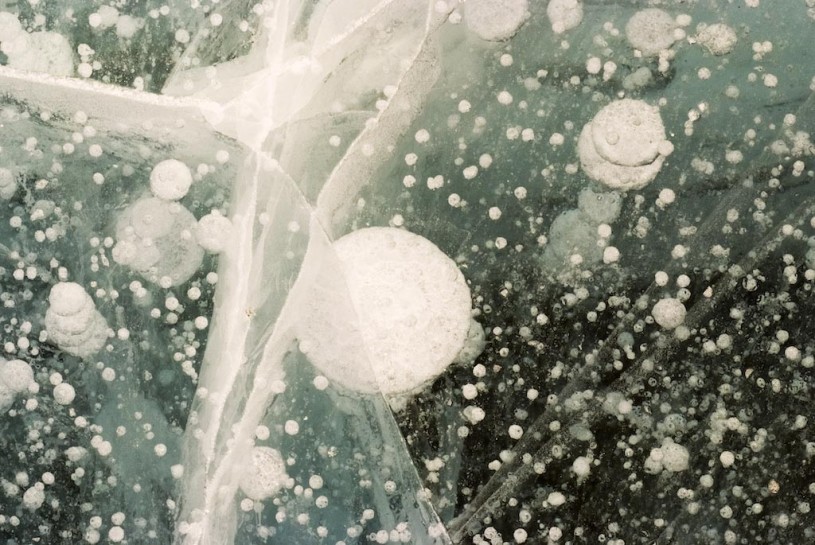Natural History Museum of Los Angeles County Presents Frozen in Time: Images of Antarctica
Thursday, May 23, 2019–Monday, January 20, 2020
WHAT
The Natural History Museum of Los Angeles County (NHM) presents the temporary art exhibition Frozen in Time: Images of Antarctica. The exhibition showcases the work of artist Diane Tuft through 13 large-scale photographs taken in 2012 while Tuft was there on a National Science Foundation (NSF) Antarctic Artists & Writers grant.
Tuft visited Antarctica intending to photograph the depletion of the ozone layer, but instead focused on the history of climate change recorded within Antarctica’s icy landscape. Tuft’s photographs capture Antarctica’s landscape
in abstracted ways—confronting the viewer with a new perspective. As Tuft states, “The Antarctica I saw was a place that served as a real-life time capsule, a perfectly preserved record of hundreds of millions of years of biological and geological history."
Tuft went through the same rigorous training all Antarctic explorers must undertake to prepare for her trip, reaching the continent’s rarely witnessed remote landscapes by braving minus 40F temperatures and 67mph winds. Complimenting the journey of Antarctic adventurer-scientists featured in the ongoing exhibition Antarctic Dinosaurs, the photographs in Frozen in Time: Images of Antarctica give visitors another way to experience the continent—through the eyes of an artist.
Gallery information will be provided in English and Spanish. Tuft’s book, Gondwana: Images of an Ancient Land will be available for purchase.
WHEN
Frozen in Time: Images of Antarctica
Thursday, May 23, 2019–Monday, January 20, 2020
Antarctic Dinosaurs
On view now through January 5, 2020
WHERE
Natural History Museum of Los Angeles County
900 Exhibition Blvd., Los Angeles, CA 90007
TICKETS
Frozen in Time: Images of Antarctica is included with museum admission. For tickets and more information, visit NHM.ORG/frozenintime.
Antarctic Dinosaurs is free for museum members. For tickets and more information, visit NHM.ORG/dinos.
There is also free General Admission, all the time, for California EBT cardholders with I.D., California teachers with I.D., and active or retired military with I.D.
Groups of 10 or more people receive discounted rates on Museum admission. Group tickets available now by calling 213.763.3218 or by emailing groupsales@nhm.org for reservations and more.
SOCIAL
Join the conversation online!
#NHMLA
Follow us @nhmla
Facebook | Twitter | Instagram | Snapchat
ABOUT DIANE TUFT
Diane Tuft is a mixed media artist who has focused primarily on photography since 1998. Tuft has always been fascinated by how environmental factors shape the Earth’s landscape, and capturing this through her camera has been a guiding principle in her work. By traveling to the most remote places throughout the world, including both the North and South Poles, she has been able to document the visual effects of climate change and global warming on our planet.
Tuft is the author of three monographs, titled UNSEEN: Beyond the Visible Spectrum; Gondwana: Images of an Ancient Land and The Arctic Melt: Images of a Disappearing Landscape. She has had solo exhibitions at the National Academy of Sciences in Washington, D.C., Bruce Museum in Greenwich, Connecticut, Southampton Center in Southampton, New York, Kimball Art Center in Park City, Utah, as well as Marlborough Gallery, Ameringer-Yohe Gallery, and Pace Gallery in New York City. Her work is included in the permanent collection of The Whitney Museum of American Art, The International Center of Photography in New York City, The Parrish Art Museum in Water Mill, New York, as well as numerous private collections. Tuft lives and works in New York City.
Learn more: www.dianetuft.com
ABOUT NHMLAC
The Natural History Museums of Los Angeles County (NHMLAC) include the Natural History Museum, La Brea Tar Pits, and the William S. Hart Museum. They operate under the collective vision to inspire wonder, discovery, and responsibility for our natural and cultural worlds. The museums hold one of the world’s most extensive and valuable collections of natural and cultural history—more than 35 million objects. Using these collections for groundbreaking scientific and historic research, the museums also incorporate them into on- and offsite nature and culture exploration in L.A. neighborhoods, and a slate of community science programs—creating indoor-outdoor visitor experience that explore the past, present, and future.
